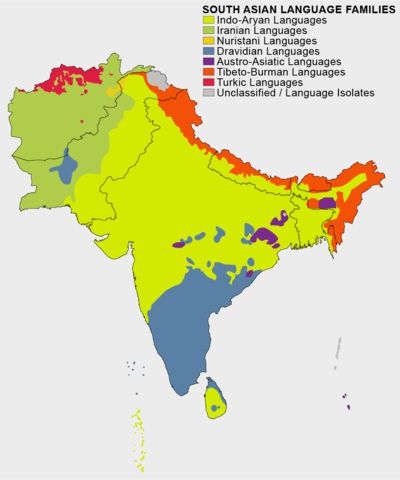Languages of South Asia


South Asia is home to several hundred languages, spanning the countries of Afghanistan, Bangladesh, Bhutan, India, Nepal, Pakistan and Sri Lanka. It is home to the third most spoken language in the world, Hindi–Urdu; and the sixth most spoken language, Bengali. The languages in the region mostly comprise Indo-Iranic and Dravidian languages, and further members of other language families like Austroasiatic and Tibeto-Burman languages.
South Asian English is considered the international lingua franca of the South Asian countries.
Afghanistan[]
The official languages of Afghanistan are Pashto and Dari, both of which are Iranic languages. Dari, an Afghan standardized register of the Persian language, is considered the lingua franca of Afghanistan and used to write Afghan literature. Tajik is spoken by people closer to Tajikistan, although officially the language is regarded same as Dari. A few Turkic languages like Uzbek and Turkmen are also spoken near regions closer to Uzbekistan and Turkmenistan.
Bangladesh[]
Bengali is the language of the majority of the people of Bangladesh and is the national language.[1] Some ethnic minority groups also use Tibeto-Burman languages.[1]
Bhutan[]
Dzongkha is the national language of the Kingdom of Bhutan. Almost all the languages of Bhutan are from Tibetic family (except Nepali, an Indo-Aryan language).
India[]
Most languages spoken in India belong either to the Indo-Aryan (c. 74%), the Dravidian (c. 24%), the Austroasiatic (Munda) (c. 1.2%), or the Tibeto-Burman (c. 0.6%) families, with some languages of the Himalayas still unclassified. The SIL Ethnologue lists 461 living languages for India.
Hindustani is the most widespread language of India. The Indian census takes the widest possible definition of "Hindi" as the broad variety of the Hindi languages. The native speakers of Hindi so defined account for 39% of Indians. Bengali is the second most spoken language of South Asia, found in both Bangladesh and Indian states of West Bengal and Tripura. The International Mother Language Day was created by UNESCO to commemorate the Bengali language.[2] Other notable languages include Odia, Telugu, Punjabi, Marathi, Tamil, Urdu, Gujarati, Kannada, Pashto, Malayalam and Konkani.
Thirteen languages account for more than 1% of Indian population each, and between themselves for over 95%; all of them are "scheduled languages of the constitution."
Scheduled languages spoken by less than 1% of Indians are Santali (0.64%), Manipuri (0.14%), Bodo (0.13%), Dogri (0.01%, spoken in Jammu and Kashmir). The largest language that is not "scheduled" is Bhili (0.95%), followed by Gondi (0.27%), Tulu (0.17%) and Kurukh (0.099%)
Nepal[]
Most of the languages of Nepal either fall under Indo-Aryan languages or Sino-Tibetan languages. The official language of the country is Nepali, earlier known as Gorkhali in the Kingdom of Nepal, and is the mother tongue of around half the population.
Pakistan[]
The major languages of Pakistan broadly fall under the category Indo-Iranian languages, with western regions of Pakistan (close to Iran and Afghanistan) speaking Iranic languages and eastern regions (close to India) speaking Indo-Aryan languages (with the Indus River approximately dividing the families). The national uniting medium of Pakistan is Urdu, a persianized register of the Hindustani language. The major native languages of Pakistan are Baluchi, Punjabi, Sindhi and Pashto, while other languages like Saraiki, Balti, etc. are also widely spoken.
Sri Lanka[]
Sinhala and Tamil are the official languages of Sri Lanka, with Sri Lankan English as the link language. Tamil is a South-Dravidian language, and Sinhala belongs to the Insular Indic family (along with Dhivehi of Maldives). Vedda is said to be the indigenous language of Sri Lanka before the arrival of Aryans and Dravidians.
See also[]
- Languages of Asia
- Languages of Bangladesh
- India:
- Official languages of India
- List of languages by number of native speakers in India
- Languages of Maldives
References[]
- ^ a b "Bangladesh - Languages | Britannica". www.britannica.com. Retrieved 2022-01-10.
- ^ "The General Conference proclaim"International Mother Language Day" to be observed on 21 February". unesdoc.unesco.org. 1999-11-16. Retrieved 2019-04-21.
- Data table of Census of India, 2001
- "Indian Language Family". Central Institute of Indian Languages. Archived from the original on 15 June 2002.
- SCHEDULED LANGUAGES IN DESCENDING ORDER OF SPEAKERS' STRENGTH – 2001
- COMPARATIVE RANKING OF SCHEDULED LANGUAGES IN DESCENDING ORDER OF SPEAKERS' STRENGTH-1971, 1981, 1991 AND 2001
- Census data on Languages
External links[]
- Languages of South Asia